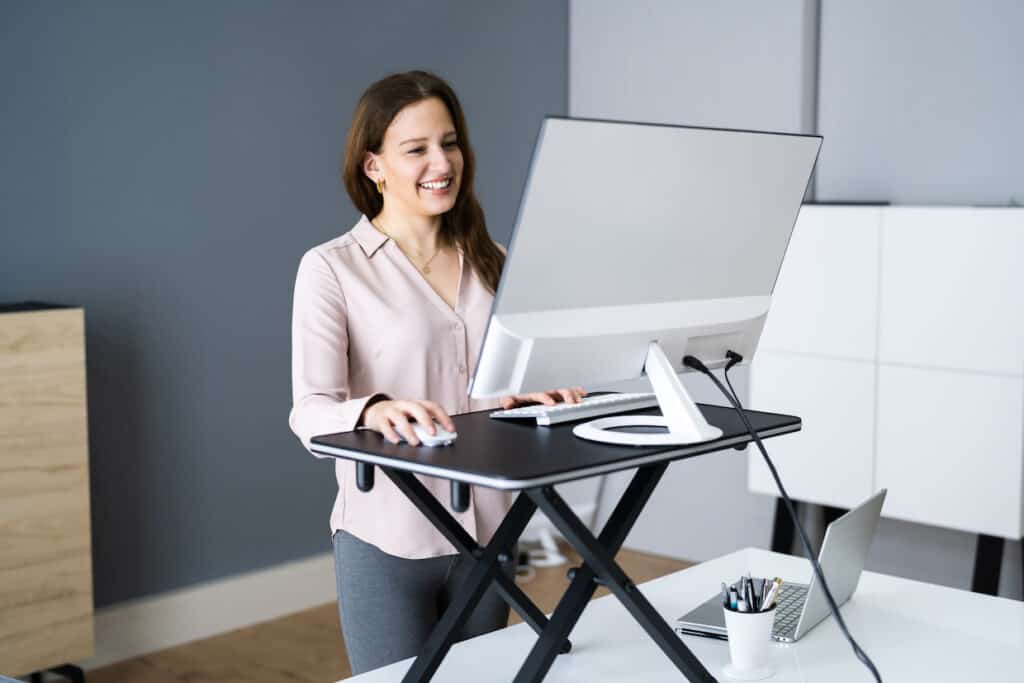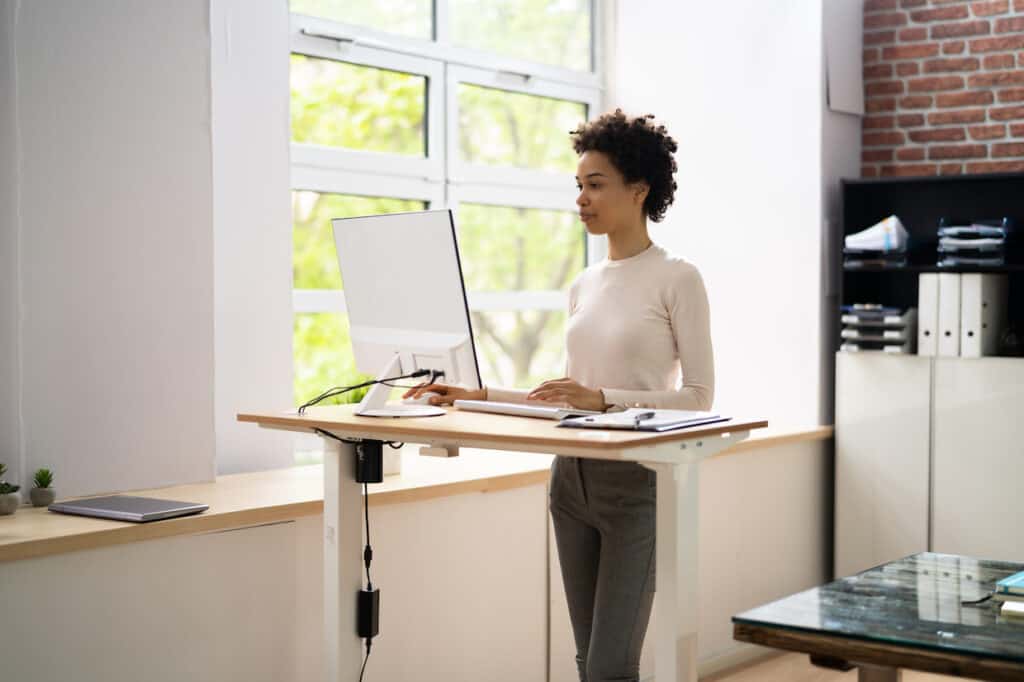If you want to improve your health and well-being, there’s a simple thing you can do: stand up. This is especially true if you have a desk job. This article provides information about the benefits of a standing desk and how you can set one up at home.

Sitting at a desk and your health
It seems almost contradictory. You’re working at your desk for hours, seemingly comfortable in your chair, and what happens when you finally stand up? You’re sore and stiff.
However, think back to the last road trip you took. Even if you own a high-end car, chances are that when you got out at your first stop, your body was talking back to you. That’s why it feels so good to stretch when you get up from a seated position.
It turns out that sitting — in a car or at work — isn’t good for you. According to the Mayo Clinic, when you have prolonged periods of sitting on a regular basis, you may make yourself more susceptible to unhealthy outcomes, such as:
- Increased blood pressure.
- High blood sugar.
- Excess body fat around the waist.
- Unhealthy cholesterol levels.
Creating a standing desk
So, how can you make a change? Create an exercise desk or walking desk, which is a combination of a standing desk and a walking pad. That’s a small treadmill without arms or a screen. Another option for a walking desk is to find a tall table with wheels that can roll over an existing treadmill like Sage Scott of Everyday Wanderer did.
“I can easily roll the table into place perpendicular to the walking surface,” she explained. “I walk at a steady 1.1 mph speed most of my work day. The only time I turn off the tread and stand still is when I’m on video calls.”
Or, you can set up a stationary, standing desk in the form of an adjustable height, freestanding table. That’s the approach Laura Sampson of Little House Big Alaska took. “My desk is adjustable. The whole thing lifts up,” she explained. “I plan to buy a treadmill that will go under it so I can also walk while I work. It will be really helpful in bad weather to get my steps in every day.”
Also, there are adjustable-height laptop stands that sit on a regular desk. When you have your computer equipment on one of these, you can raise the height of the stand so you can go from sitting to standing without interrupting your workflow.

Finally, if you’re not coordinated enough to walk or stand while you work, consider how Lara Clevenger of Lara Clevenger approached an exercise desk: she got a bike desk. Literally, a desk mounted on top of a spin bike. If you have a Peloton bike, there are even laptop trays that sit on the bike handlebars and hold a computer.
Ergonomics of a standing desk
When it comes to setting up a standing or walking desk, it isn’t just about getting out of your chair. For starters, you want to make sure you’re wearing comfortable shoes that can support your being on your feet all day. Also, you may also want to invest in an anti-fatigue mat like chefs use.
In addition, its ergonomics play a big part in setting you up for a comfortable workstation. That is, you want a computer setup that actually feels good for you, head to toe, much like a kitchen knife that is comfortable to hold and won’t leave your hands or wrist hurting.
Derrek Wiedeman, an engineer by training, is a co-creator of the StandMore desk. This desk looks more like a tripod than a workstation. It is designed to be portable, so you can take it with you if you want to move around your office or if you’re working on the road.

Wiedeman offered the following tips for setting up an ergonomically correct standing desk. It’s important to point out that these tips are based on a traditional computer setup, with a separate monitor, keyboard and mouse. If you use a laptop, you may want to invest in a monitor, wireless keyboard and Bluetooth mouse in order to achieve an optimum setup.
Monitor, keyboard and mouse arrangements
When deciding at which height to have your desk, start with the monitor. Ideally, you want to be looking straight ahead and have your eye level fall somewhere between the top and the middle of the screen or monitor. This should help reduce neck issues. The monitor shouldn’t be so far away that you have to lean forward or squint to see it. At the same time it shouldn’t be so close that it causes eye strain.

Next, you want to ensure that your keyboard and mouse are positioned in such a way that you aren’t hunched over or don’t have to reach to use them. Wiedeman suggested setting the height of the keyboard and mouse surface with the following in mind:
- Your shoulders are relaxed.
- Your elbows are at a 90-degree angle.
- Your wrists are straight and can lie flat.
Finally, don’t forget about your feet. “Position your feet shoulder-width apart and parallel to each other,” Wiedeman said. “Distribute your weight evenly on both feet, avoiding excessive pressure on one foot. Consider using a footrest to support your feet and promote a more comfortable stance.”
Health benefits of standing to work
Now that you know the health risks associated with sitting to work, it’s important to point out the health benefits of standing to work. According to office furniture design company Steelcase, maker of some of the first standing desks for offices, a long-term survey of employees using standing workspaces found the following positive effects:
- Nearly half reported a significant reduction in upper back, shoulder or neck discomfort.
- Two-thirds reported increased productivity after one year.
- Two-thirds said height-adjustable desks positively impacted their health outside of the workplace.
Those surveyed also reported feeling that they could concentrate better at work. And, overall, they said they were more active, refreshed, awake, limber and energetic.
Final thoughts
Who wouldn’t want to feel more refreshed and energetic after working all day? Hopefully, these outcomes convince you that by using a standing, walking or exercise desk, you can practice self-care and still be productive in your job.
Leah Ingram, author of 15 books, including “Suddenly Frugal: How to Live Happier and Healthier for Less” and “The Complete Guide to Paying for College,” created a DIY treadmill desk more than a decade ago. She shares shopping advice for getting the most value for your time and money at Leah Ingram Real Sophisticated Consumer.